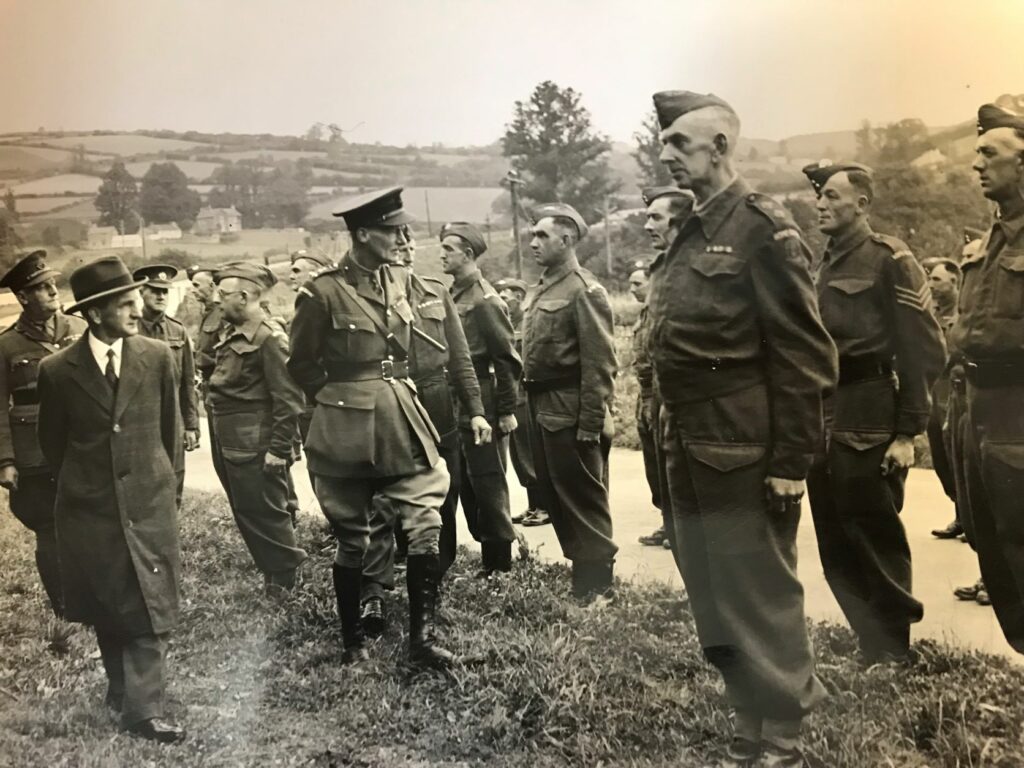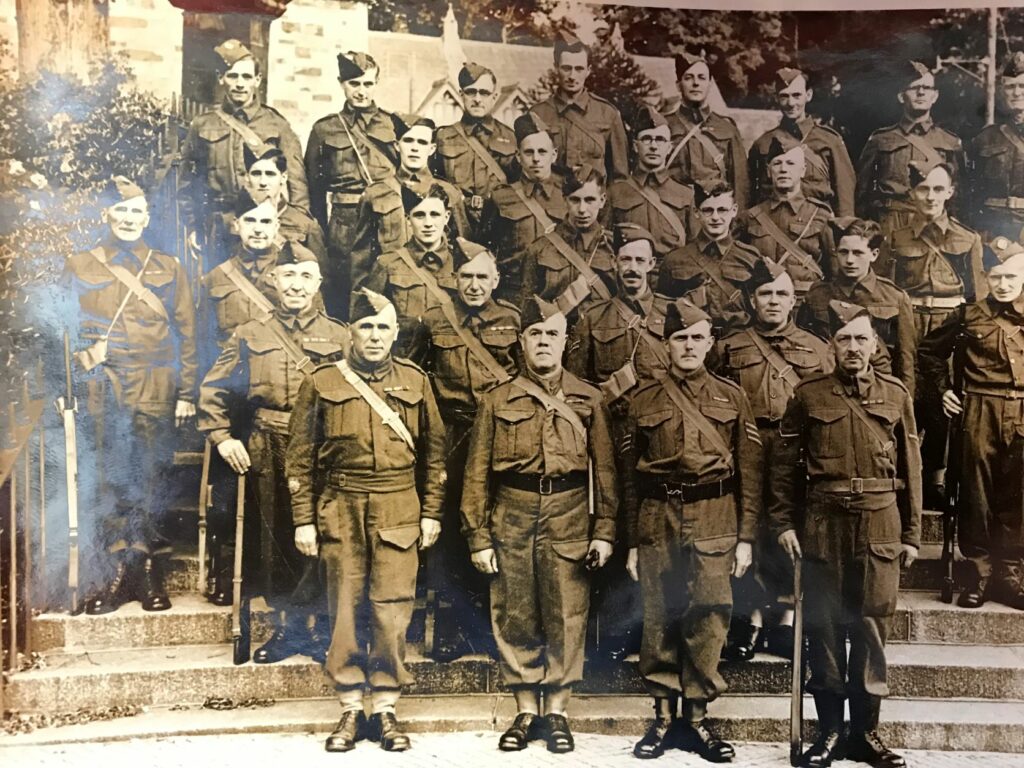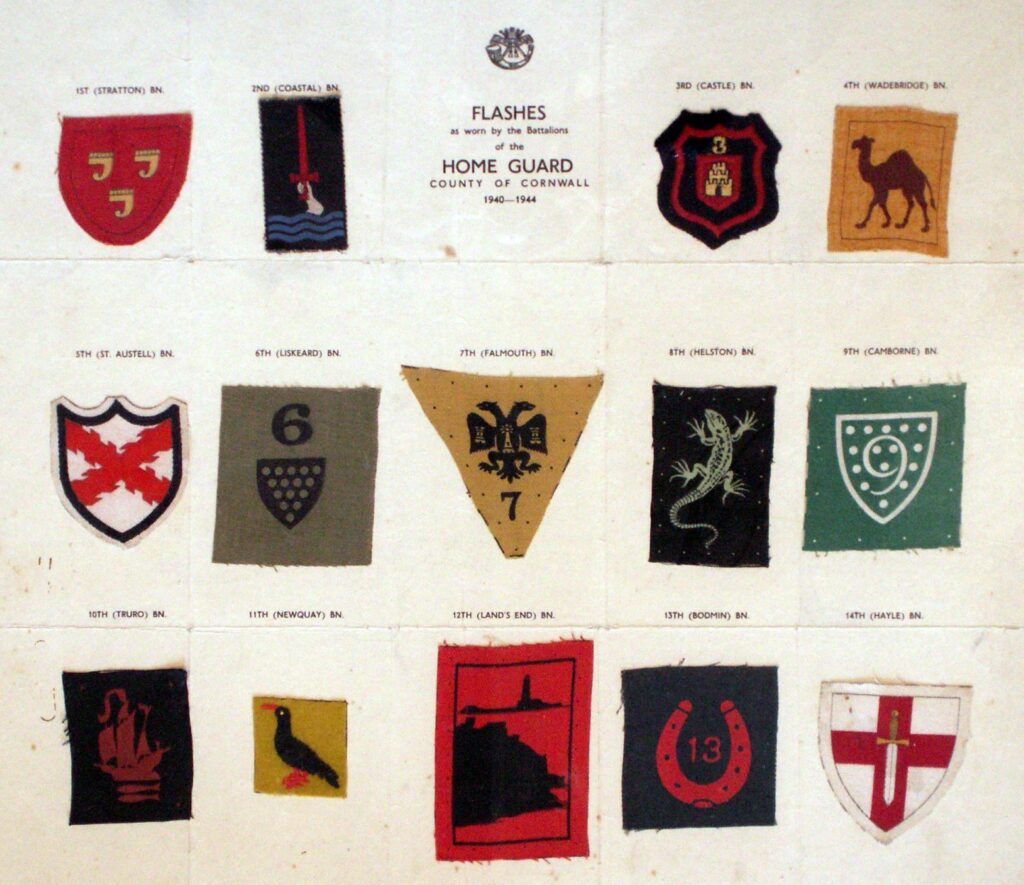During the Second World War and only 4 days after Churchill had become Prime Minister, his war secretary Anthony Eden announced on the BBC that there would be a formation of a Local Defence Force (LDF), an armed citizen militia that would be set up to support the British Army and to protect the country against attacks from the Nazi enemy. Coined The Home Guard by Churchill, it’s job was to hold off the enemy if Britain was invaded from the sea, until the regular troops could arrive.
The fear of German invasion at this time was extreme and Britain was at a very low ebb around May & June 1940. The evacuation of Dunkirk had left a lot of weapons and equipment behind, and it was feared the Germans would use these as part of an invasion. The British thought that the Germans had a force of about 100,000 airborne troops but in fact they only had 7,000, so a successful invasion was in fact far less likely than feared.

Bodmin Home Guard being inspected. Credit George Ellis Collection, Kresen Kernow
You will not be paid, but you will receive a uniform and will be armed.
Operational from 1940 to 1944, the Home Guard had 1.5 million local volunteers, these were mainly men who were either too young (under 18 years) or too old (over 41 years) for regular military service. Nearly half of the Home Guard were men who had fought in the First World War and earlier wars. It was also made up of those people who worked in reserved occupations, jobs which were deemed too important for the country and who were therefore required by law, to stay in post and prohibited to join up.
All able-bodied men between the ages of 17 and 65 years were called to enrol at their local police station, Eden stated: “You will not be paid, but you will receive a uniform and will be armed.” The government had anticipated that 500,000 men might volunteer, however the influx of volunteers to the LDV greatly exceeded expectations, by July 1940, 1.5 million applicants had been recorded. And Churchill would regularly praise the dedication of its volunteers in his wartime broadcasts.

The First Patrols
From 15th May 1940, even before they had official instructions about what to do, volunteers, often from local football clubs and hunts across the country, started to set up their own patrols, looking for enemy parachutists and coastal landings. All county Home Guard battalions fell under the direction of regional headquarters which were organised into areas and commands, each county having several local battalions, the Cornwall Home Guard was in the South-Western Area under Southern Command.
Cornwall’s Home Guard
Cornwall’s Local Defence Volunteers were officially formed on 17th May 1940, the man in charge was Brigadier General W D Croft. He had minimal guidelines to follow – he just knew that he had to raise Companies of soldiers for each police division in the county. Within 48 hours Companies (which might be up to 120 men) had been established at Land’s End, Camborne, Falmouth, Truro, St Austell, Liskeard and Launceston. Eventually there were Home Guard battalions across the county from Stratton to Lands’ End.
Cornwall had 14 Home Guard battalions plus an independent company recruited among the residents of the Isles of Scilly. Typically, each Home Guard in the county had around a thousand volunteers in each of its battalions. Totalling as many as 15,000 recruits by the end of 1940. Each local battalion had its own shoulder flash depicting an emblem symbolising some old Cornish tradition, a Cornish family, or geographical connection to the area their battalion covered. These ‘arm flashes’ were sew-on badges – including a Camel for Wadebridge, a Lizard for Helston, the Killigrew family crest (a double headed eagle) for Falmouth, a chough for Newquay (this was their nickname).

Bodmin, the Home Guard’s 13th Battalion
Bodmin the 13th Battalion had its HQ at the territorial drill hall at St Blazey. Bodmin was a military hub anyway with the Victoria Barracks and Keep of the DCLI and later in the war the American Trioops were garrisoned around the town prior to the D Day landings.
As Cornwall is a coastal county, and therefore, vulnerable to the possibility of German attack by sea, the local Home Guard battalions were tasked with coast-watching duties. In the event of an attack or invasion, they would be responsible for defending the Cornish coastline until the regular armed forces arrived.
In order for the Cornwall Home Guard to be at full readiness for all eventualities, it was necessary for their volunteers to conduct regular drills and engage in constant training. This also involved taking part in exercises and manoeuvres, to rehearse their role as an anti-invasion force.
Rifle companies of Bodmin’s 13th were stationed at Lanivet, Bodmin, Lostwithiel, Fowey and Par, in total numbering some 1,200 men, exact locations of their platoons are not known but likely to have been parish churches and village halls. Territorial Drill Halls operated as Battalion HQ’s and the County Territorial Association took over the running and maintenance of the home guard.
With ammunition and artillery prioritised for the troops fighting on the continent, the Home Guard volunteers were often short of standard army issue weapons, however, the number of private rifles and shot guns in their possession was higher than the national average – almost 1,000 hunting rifles and over 6,000 shotguns.
The End of The Home Guard
The Home Guard was created at a time of great worry and undoubtedly raised the morale of the general public. These men had to show tremendous initiative and make do with the far from perfect weapons and resources at a time of great shortages. And it was surely the case that many young men in Cornwall’s Home Guard did eventually sacrifice themselves on the field of battle some years later, when they were old enough and called up for service in the armed forces for battles in North Africa, Italy, Burma and Normandy.
In his conclusion to the assessment of the home Guard in Cornwall during the war, Lieutenant Colonel Holman wrote
‘Many tributes have been paid to the loyalty of the home guard through these hard years. I will not try to rival them, but will end with the memory of a wild bitter night deep in the winter of 1940-41. A crude small shack crouched under a cliff edge overlooking the Atlantic. Six men on duty after a long day’s work; two on guard, 4 resting. No bands, no pay, no medals no glory. The sublime devotion to duty of it rung in my heart then, as it has often since. and so, fare you well my friends, as right well you deserve to fee.’
The home guard was ‘stood down’ on Sunday 3rd December 1944 with parades through Cornwall. All serving members of the Home Guard received a certificate of service.

